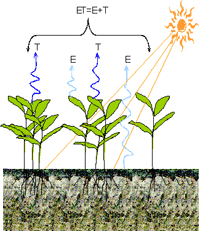Agricultural Research Division of IANR

West Central Research and Extension Center, North Platte
Date of this Version
2023
Citation
J. Environ. Qual. 2023;1–11.
DOI: 10.1002/jeq2.20472
Abstract
Currently, the concept of plant capture efficiency is not quantitatively considered in the evaluation of off-target drift for the purposes of pesticide risk assessment in the United States. For on-target pesticide applications, canopy capture efficiency is managed by optimizing formulations or tank-mixing with adjuvants to maximize retention of spray droplets. These efforts take into consideration the fact that plant species have diverse morphology and surface characteristics, and as such will retain varying levels of applied pesticides. This work aims to combine plant surface wettability potential, spray droplet characteristics, and plant morphology into describing the plant capture efficiency of drifted spray droplets. In this study, we used wind tunnel experiments and individual plants grown to 10–20 cm to show that at two downwind distances and with two distinct nozzles capture efficiency for sunflower (Helianthus annuus L.), lettuce (Lactuca sativa L.), and tomato (Solanum lycopersicum L.) is consistently higher than rice (Oryza sativa L.), peas (Pisum sativum L). and onions (Allium cepa L.), with carrots (Daucus carota L.) showing high variability and falling between the two groups. We also present a novel method for three-dimensional modeling of plants from photogrammetric scanning and use the results in the first known computational fluid dynamics simulations of drift capture efficiency on plants. The mean simulated drift capture efficiency rates were within the same order of magnitude of the mean observed rates of sunflower and lettuce, and differed by one to two orders for rice and onion. We identify simulating the effects of surface roughness on droplet behavior, and the effects of wind flow on plant movement as potential model improvements requiring further species-specific data collection.


Comments
Creative Commons Attribution License,